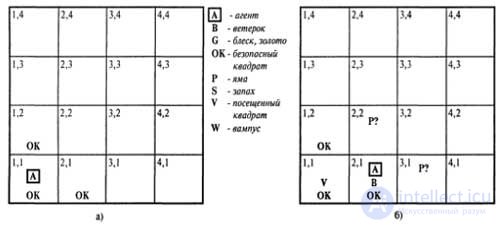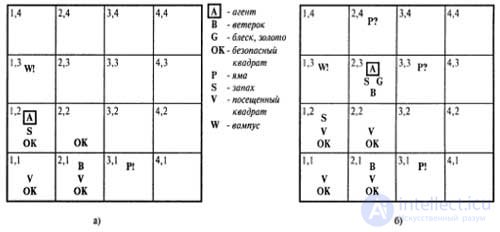Lecture
 |
| An example of the world of vampus. The agent is in the lower left corner. |
The results of acts of perception are transmitted to the agent in the form of a list of five characters; for example, if there is an unpleasant smell and breeze, but there is no shine, blow or cry, the agent perceives the results of the act of perception [Stench, Breeze, None, None, None].
It is proposed to determine the vampus environment in accordance with various measurements. The main difficulty for this agent is that from the very beginning he does not know the configuration of his environment; apparently, to overcome this ignorance, it is impossible to do without logical reasoning. In most instances of the vampus world for an agent, it is possible to safely receive gold. But sometimes an agent has to choose: return home empty-handed or risk his life to find gold. About 21% of the variations of the environment are completely unfavorable, since gold is in a pit or surrounded by pits.
We trace the agent for the world of vampus, acting on the basis of knowledge, which studies the environment shown in the figure. The initial knowledge base of the agent contains the rules of existence in this environment, which were described above; in particular, the agent knows what is in the square [1,1] and that the square [1,1] is safe. We will see how the knowledge of the agent expands as the results of new acts of perception arrive and actions are performed.
The first perception is [None, None, None, None, None], on the basis of which the agent can conclude that the adjacent squares are safe. The figure, a, shows the state of knowledge of the agent at that moment. We will enumerate (some) statements from the knowledge base using letter symbols such as B (a breeze is felt) and OK (safely, neither pits nor vampus) in the corresponding squares. On the other hand, the figure depicts this world itself.
 |
| The first step performed by an agent in the vampus world: the initial situation that arose after perception / "None, None, None, None, None 7 (a); the situation after one move, in which perception was obtained /" None, Breeze, None, None, None] F) |
Based on the fact that there was no unpleasant odor or breeze in the square [1,1], the agent can conclude that the squares [1,2] and [2,1] are free from danger. To indicate this, they are labeled OK. A cautious agent goes only into such a square, which is known to have an OK mark in it. Suppose that the agent decided to move forward, to the square [2,1], and the scene shown in the figure was created.
The agent detects a breeze in the square [2,1], so there must be a hole in one of the neighboring squares. According to the rules of the game, the pit cannot be in the square [1,1], therefore it must be in the square [2,2], or [3,1], or in both. Designation P? in the figure, b indicates the possibility of the presence of pits in these squares. At the moment, only one square is known with an OK mark, which has not yet been visited. Therefore, a prudent agent turns around and returns to the square [1,1], and then goes to the square [1,2].
The new perception in the square [1,2] is [Stench, None, None, None, None], which leads to the state of knowledge shown in the figure. The presence of an unpleasant odor in the square [1,2] means that there is a vampus somewhere nearby. But a vampus cannot be in the square [1,1] according to the rules of the game and cannot be in the square [2,2] (since the agent would detect an unpleasant smell being in the square [2,1]). Therefore, the agent can conclude that the vampus is in the square [1,3]. This is indicated by the designation W !. In addition, the lack of perception of Breeze in the square [1,2] implies that there is no hole in the square [2.2]. Nevertheless, we have already concluded that the pit should be in the square [2.2] or [3, 1], which means that it is indeed in the square [3,1]. This is a very complex logical conclusion, since it combines knowledge obtained at different times in different places, and it makes the decision to perform an important step based on the lack of a certain perception. Such a logical conclusion is superior to the abilities of most animals, but is typical of this kind of reasoning performed by logical agents.
 |
| The last two stages during the agent's activity: after the third move, when the perception was received / "Stench, None, None, None, None] (a); after the fifth move, when the perception was received /" Stench, Breeze, Glitter, None, None] F) |
Now the agent has proved to himself that in the square [2,2] there is neither a pit nor a vampus, therefore, he can designate this square with the OK mark in order to go into it. We do not show the state of knowledge of the agent in the square [2, 2], but simply assume that the agent turned and went into the square [2, 3], as a result of which the state shown in the figure was obtained. In the square [2,3] the agent detects brilliance, so he must grab the gold and thereby end the game.
In each case, when the agent draws a conclusion from the information available to it, the correctness of this conclusion is guaranteed, if the information available is correct. This is the fundamental property of logical reasoning. The remainder of this chapter will show you how to create logical agents that can provide the necessary information and draw the conclusions described in the previous paragraphs.
Comments
To leave a comment
Miscellaneous
Terms: Miscellaneous